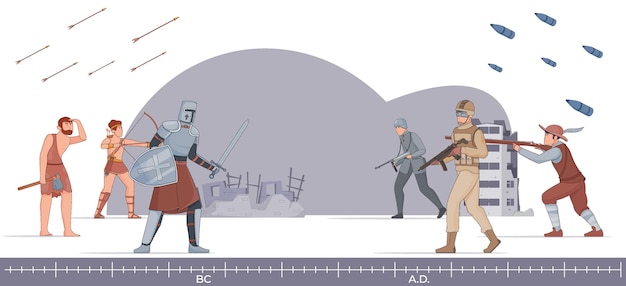

The Battle of Gettysburg lasted for three days, from July 1st to July 3rd, 1863.
It was one of the bloodiest battles of the American Civil War, with an estimated 51,000 casualties.
Prior to the battle, the town of Gettysburg was a site for a college and a prosperous farming community.
General Robert E. Lee led the Confederate Army, while General George G. Meade commanded the Union Army.
The battle took place in and around Gettysburg, Pennsylvania, primarily on the hilly terrain.
On the first day of the battle, the Confederates pushed the Union troops back but failed to secure a decisive victory.
Pickett’s Charge was a major assault launched by the Confederates on the third day, but it ultimately failed.
The turning point of the battle came when Union forces successfully defended Cemetery Hill and Culp’s Hill.
The Gettysburg Address, one of the most famous speeches in American history, was delivered by U.S. President Abraham Lincoln at a ceremony to consecrate the National Cemetery.
The battle was fought over strategic control of transportation routes and for the Confederate Army to gain recognition from European powers.
Rivalry between Confederate generals Longstreet and Lee played a significant role in the outcome of the battle.
Gettysburg’s Lutheran Theological Seminary served as a lookout point during the battle and sustained damage.
Civilian casualties were reported during the battle, including the deaths of Gettysburg residents and destruction of their properties.
The National Park Service now preserves most of the battlefield as Gettysburg National Military Park.
The intense fighting resulted in numerous artillery shells being fired, with some still being discovered today.
Confederate General Richard Ewell’s decision not to seize Cemetery Hill on the first day is widely debated as a missed opportunity for the South.
Some areas of the battlefield are said to be haunted, with numerous ghost sightings reported.
The battle was fought during a heatwave, with high temperatures reaching over 90°F (32°C).
A young Confederate soldier named Johnston Jack Skelly served as a drummer boy during the battle.
Approximately 3,500 horses were killed during the battle, both from combat and from the grueling conditions.
The battle was observed by curious locals who watched from nearby hills and witnessed the devastation.
The 20th Maine Volunteer Infantry Regiment played a crucial role in defending Little Round Top on the second day.
Despite the battle’s significance, it almost didn’t take place in Gettysburg. Initially, Lee intended to concentrate his forces near Harrisburg, Pennsylvania.
The battle’s aftermath left a lasting impact on the town’s economy, with significant damage requiring years of rebuilding.
Soldiers often used stone walls and fences as makeshift defensive positions during the battle.
George Washington Sandoe, a Union soldier, returned to Gettysburg years later and operated a photography studio, capturing images of the battlefield and veterans.
The steeple of the Lutheran Theological Seminary was used as an observation post during the battle.
The battle influenced the outcome of the Civil War and played a role in President Lincoln’s re-election.
Soldiers from both sides created intricate carvings on trees, some of which can still be seen today.
The battle’s casualty rate was higher for Confederate troops, as they suffered heavier losses.
The first soldier killed during the battle was Confederate Private Henry T. Zoeller.
Several famous war correspondents, including William H. Tipton and Alexander Gardner, captured iconic photographs of the aftermath and burial of soldiers.
This battle marked the first significant engagement of the war on Union territory.
Confederate General James Longstreet disagreed with Lee’s offensive strategy on the third day, favoring a defensive approach instead.
A total of 160 cannons were used during the battle, contributing to the intense artillery bombardment.
General Lee’s failed invasion of the North, culminating in the Battle of Gettysburg, significantly impacted Confederate morale.
Soldiers on both sides experienced severe dehydration and heat exhaustion due to the sweltering weather conditions.
The battle left many families without fathers, sons, and brothers, creating a lasting impact on the communities involved.
Gettysburg residents played a significant role in assisting wounded soldiers and burying the dead after the battle.
The battle marked a turning point in the war, as it shifted momentum in favor of the Union forces.
The area surrounding Gettysburg is known for its picturesque countryside, attracting visitors interested in both history and natural beauty.
The town’s name, Gettysburg, originates from founder James Gettys, who established a tavern nearby in the 1760s.
The battle’s aftermath saw an increase in the establishment of military hospitals to care for the wounded.
The Gettysburg Cemetery, where the Gettysburg Address was delivered, is the final resting place for over 3,500 Union soldiers.
The Battle of Gettysburg is commemorated annually, attracting reenactors, history enthusiasts, and visitors from around the world to learn about this crucial event in American history.
Around the world, coffee enthusiasts enjoy Monin coffee concentrate since it is a multipurpose product. Conveniently combining…
The Importance of Choosing the Right Shower for Your Bathroom Renovating your bathroom can be…
Usain Bolt holds the record for the fastest 100-meter sprint in history.Bolt was named Sportsman…
Love is in the air... and it smells suspiciously like chocolate!Roses are red, violets are…
Life's a beach, take a picture and relax.Sun, sand, and salty kisses. That's what beach…
Hungary is home to the largest thermal water cave system in the world.The Rubik's Cube…